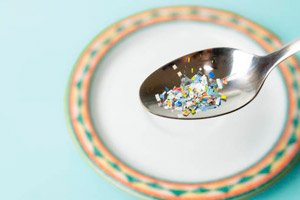
All iLive content is medically reviewed or fact checked to ensure as much factual accuracy as possible.
We have strict sourcing guidelines and only link to reputable media sites, academic research institutions and, whenever possible, medically peer reviewed studies. Note that the numbers in parentheses ([1], [2], etc.) are clickable links to these studies.
If you feel that any of our content is inaccurate, out-of-date, or otherwise questionable, please select it and press Ctrl + Enter.
Nanoplastics Destroy "Gut-Liver-Brain": New Threat in Alzheimer's Disease
Last reviewed: 09.08.2025
 ">
">Scientists from Monash University (Australia) and South China University of Technology (China) have published a detailed preclinical study in Environmental Science & Technology demonstrating that background pollution-equivalent doses of polystyrene nanoplastics (PSNPs) can not only enhance the classic brain manifestations of Alzheimer's disease (AD), but also spread the pathology beyond the central nervous system along the gut-liver-brain axis.
Prerequisites
Plastic pollution is a universal environmental factor, and nanoplastics (<100 nm) permeate all ecosystems. Their impact on health has raised serious concerns in recent years, but links to neurodegenerative diseases are poorly understood.
Model and design
- Animal model: APP/PS1 transgenic mice reproducing key markers of AD (β-amyloid accumulation, tau pathology).
- Exposure: Intake of 50 nm PSNP in drinking water at levels of 0.1–1 mg/kg/day for 12 weeks is a realistic range for humans.
- Assessment of cognitive functions: Morris maze test and object recognition.
- Tissue analysis:
- Brain immunohistochemistry (markers Iba1, GFAP, β-amyloid, p-tau)
- 16S rRNA sequencing of feces for microbiota
- Liver histology (HE stain, Oil Red O)
- Systemic plasma cytokine profile (ELISA for IL-6, TNF-α)
Key Results
1. Accelerated neuroinflammation and neurodegeneration
- Microglial and astrocytic response: The number of Iba1⁺ microglia and GFAP⁺ astrocytes in the hippocampus and cortex increased by 45–60% compared to unexposed APP/PS1 (p<0.01).
- Amyloid plaques and p-tau: plaque area increased by 35% and phosphorylated tau (p-tau) increased by 28% (p<0.05).
- Cognitive deficit: In the Morris maze, the time to find the hidden platform increased by 40%, and in the object recognition test, the discrimination index fell by 30% (p<0.01).
2. Intestinal dysbiosis and "leaky gut"
- Decreased α-diversity: Shannon index in microbiota decreased by 20% (p<0.05).
- Increase in pro-inflammatory genera: Escherichia/Shigella and Enterococcus increased by 60%, while beneficial Lactobacillus fell by 45%.
- Intestinal barrier function: ZO-1 protein expression in the epithelium decreased by 50%, which was accompanied by a 2-fold increase in plasma lipopolysaccharide (LPS) levels (p<0.01).
3. Liver damage and systemic inflammation
- Degree of steatosis: according to Oil Red O staining, the proportion of fatty inclusions in the liver increased by 3.5 times.
- Hepatitis-like changes: increased phagocyte infiltration and fibrosis without alcohol.
- Systemic cytokines: IL-6 and TNF-α in plasma increased by 2.0 and 1.8 times, respectively (p<0.01).
Axial propagation mechanism
The researchers propose that nanoplastics disrupt the microbiota, causing intestinal leakiness and translocation of bacterial endotoxins to the liver. There, metabolic and inflammatory damage is created that impairs the liver’s ability to detoxify neurotoxins and increases systemic levels of proinflammatory mediators. These factors, when released into the brain, trigger and accelerate the classic neurodegenerative processes of AD.
Authors' statements
“Our data demonstrate for the first time that nanoplastics act not locally but systemically, worsening not only the cerebral but also the liver and gut aspects of Alzheimer’s disease,” says Prof. Pu Chun Ke, senior author. “This highlights the urgent need to limit environmental exposure to nanoparticles and to investigate measures to protect the body’s barrier tissues.”
In the discussion, the authors highlight the following key points:
Systemic effect of nanoplastics.
“Our data show that even ecologically realistic levels of polystyrene nanoplastics are not limited to local neurotoxic effects, but trigger a cascade of inflammatory and metabolic disturbances along the gut-liver-brain axis,” notes Professor Pu Chun Ke.Destruction of barrier functions.
“Violation of the integrity of the intestinal epithelium and subsequent translocation of microbial endotoxins into the systemic bloodstream significantly aggravate not only liver but also neuroinflammatory processes,” emphasizes co-author Dr. Li Wang.Need for environmental control:
“Our findings call for a reconsideration of the allowable levels of nanoplastics in drinking water and food products, and encourage the development of barrier and probiotic strategies to protect against their harmful effects,” says Dr. Mei Zhang.
Prospects and Recommendations
- Environmental control: tightening the limits for nanoplastics in drinking water and the food chain.
- Medical monitoring: in patients with CNS dementia, assess the condition of the intestine and liver for dysbiosis and non-alcoholic steatohepatitis.
- Further studies: evaluate the effect of other types of nanoplastics (PET, PVC) and the possibility of neuroprotection through probiotics or barrier therapy.
This study places nanoplastics among new risk factors for systemic and neurodegenerative diseases that require immediate attention from both environmentalists and physicians.
